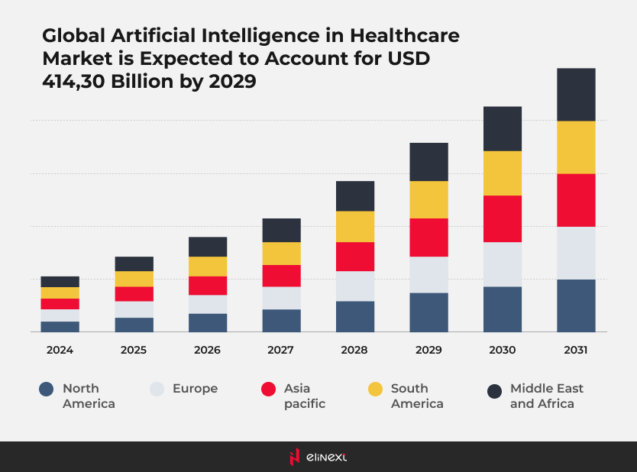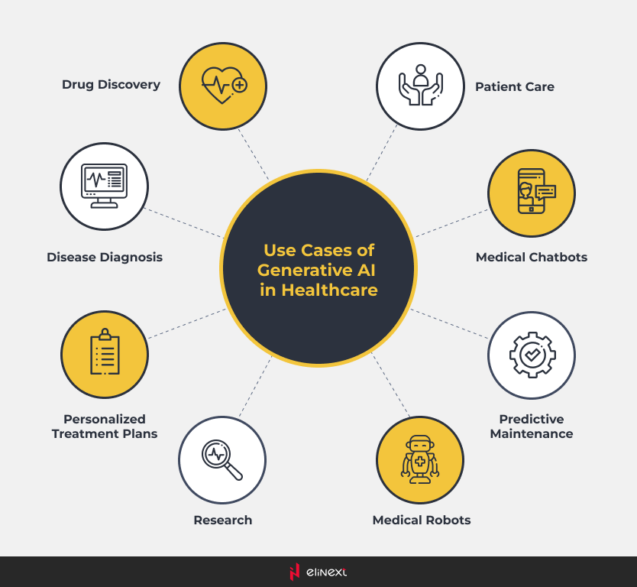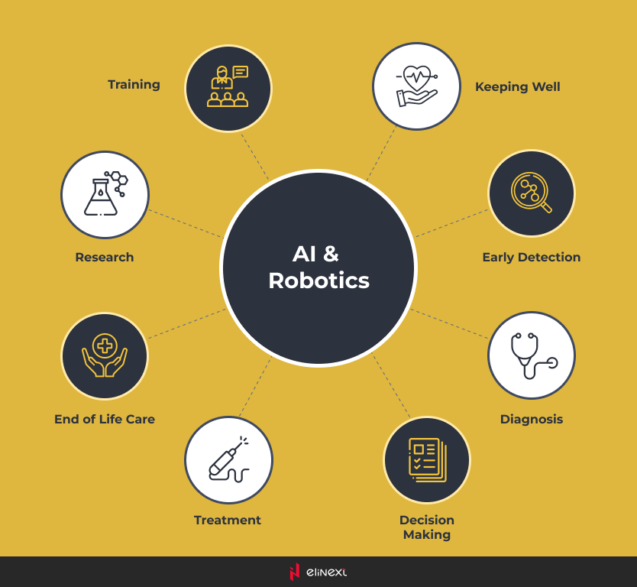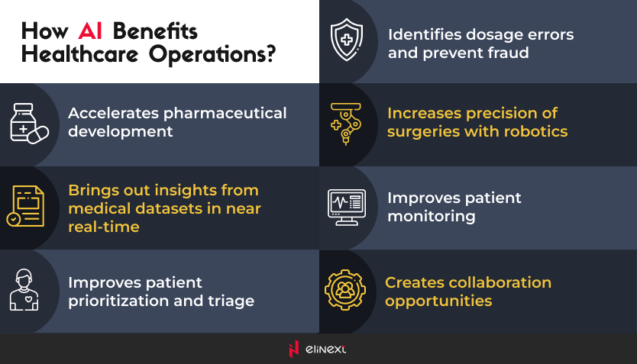In 2025, AI applications in healthcare are at the forefront of innovation, promising significant advancements in patient care and operational efficiency. The benefits of AI in healthcare are becoming increasingly apparent, ranging from improved diagnostics to personalized treatment plans.
As we explore current AI trends in healthcare, it’s crucial to balance high hopes with the reality of implementation challenges. By understanding these dynamics, stakeholders can better navigate the evolving landscape and harness AI’s full potential for future custom healthcare software development.

Challenges of AI in Healthcare
Despite the promise of AI in the healthcare industry, several challenges hinder its widespread adoption. The use of AI in healthcare often faces issues like data privacy concerns, integration with existing systems, and the need for high-quality data. Additionally, healthcare professionals may struggle to trust healthcare analytics solutions that lack transparency. Addressing these challenges is essential for realizing the true potential of AI in improving patient outcomes and operational efficiencies.
AI use cases in healthcare
AI solutions are revolutionizing healthcare through various applications, such as predictive analytics for identifying patient risks and automating administrative tasks. Notably, generative AI in healthcare is enhancing drug discovery and personalizing treatment plans, leading to improved patient outcomes.
Personalized Treatment Plans
Personalized treatment plans are enhanced by patient management solutions that leverage the impact of AI in healthcare. These AI applications in healthcare enable tailored strategies, improving patient outcomes and engagement.
Medical Imaging and Diagnostics
AI in the healthcare industry is revolutionizing medical imaging and diagnostics by improving accuracy and speed. Advanced algorithms analyze images, aiding in early disease detection and enhancing overall patient care.
Genomics and Precision Medicine
AI applications in healthcare are driving advancements in genomics and precision medicine. By analyzing vast genetic data, AI helps identify unique patient profiles, enabling tailored treatments for better health outcomes.
Mental Health Support
The impact of AI in healthcare is notable in mental health support, where AI-driven tools provide chatbots and virtual therapy. These innovations enhance accessibility, offering timely assistance and personalized care to patients.
Generative AI use cases in healthcare
Generative AI in healthcare is reshaping the landscape with innovative applications. From generating synthetic medical data for research to creating personalized treatment plans, AI use cases in healthcare are vast. This technology enhances drug design and optimizes clinical workflows, improving patient care.
Drug Discovery
mHealth app development is transforming drug discovery by enabling real-time data collection and patient monitoring. These apps facilitate communication between researchers and patients, streamline clinical trials, and enhance data analysis, ultimately accelerating the discovery process and improving therapeutic outcomes.
Medical Education
Machine Learning solutions are revolutionizing medical education by personalizing learning experiences. These tools analyze student performance, identify knowledge gaps, and recommend tailored resources, enhancing the training of future healthcare professionals and improving overall educational outcomes.
Synthetic Data Generation
The future of AI in healthcare lies in synthetic data generation, which allows for the creation of realistic patient data without privacy concerns. This technology supports robust model training, enhances clinical research, and enables better decision-making, paving the way for innovative healthcare solutions.
Virtual Health Assistants
AI for virtual health assistants is transforming patient care by providing personalized support and information. These intelligent agents can answer health queries, schedule appointments, and monitor chronic conditions, enhancing patient engagement and accessibility while freeing up healthcare professionals for more critical tasks.
Clinical Documentation Summarization
The impact of AI in healthcare is evident in clinical documentation summarization, where AI tools streamline the process of converting extensive notes into concise summaries. This improves efficiency, reduces clinician burnout, and allows healthcare providers to focus more on patient care and decision-making.

The key elements of a successful AI implementation
Reliable data
high-quality, accurate datasets ensure that AI models perform effectively, leading to better insights, improved decision-making, and trustworthy outcomes across various applications.
Thorough clinical program strategy
A thorough clinical program strategy that integrates a deep understanding of business and clinical practice is essential for successful AI implementation. This alignment optimizes resources, enhances patient care, and drives sustainable growth.
Software expertise in clinical or manufacturing
Software expertise in clinical or manufacturing settings ensures seamless integration, enhances system efficiency, and ultimately improves outcomes in healthcare or production environments.
Business analysis
Business analysis plays a vital role in visualizing data and embedding adaptive processes into clinical workflows. This approach enhances decision-making, streamlines operations, and maximizes the effectiveness of AI in healthcare settings.
Top 3 promising applications
Below are the top 3 promising applications where artificial intelligence could be a game-changer for the healthcare industry.
The automation of image analysis and diagnosis
This particular application works great for a radiologist: it can highlight specific areas on a scan, thus reducing the possibility of human error. It may even fully automate the interpretation of scans without human oversight, which could lead to enabling instant interpretations. Besides, the automation of image analysis and some recent demonstrations of improved tumor detection on MRIs and CTs are showing the way towards new opportunities for cancer prevention.
Drug improvements
AI can contribute to the identification of new potential therapies from volumes of databases on current medicines. The improvements in the efficiency and success rate of drug development, accelerating the process of adopting new medicaments, may be a great response to the treatment of deadly diseases.
Identification of patients risk
The adoption of the technique based on data in the patient’s electronic health record will help to identify patients whose chances of returning to a hospital within 30 days of discharge are high. This model works for the monetary aspect as well, as the costs associated with readmission are quite imposing. Another recent user case has demonstrated the ability to predict the risk of cardiovascular disease based solely on a still image of a patient’s retina.
This way, the first step of artificial intelligence adoption would lie in the understanding of how the data flows into AI and machine learning systems in real time, what the quality data looks like, and how it can be stored, augmented and used for future training.

The Key Benefits of AI in Healthcare
-
Improves patient monitoring
AI systems analyze real-time data, enabling timely interventions, enhancing patient safety, and fostering personalized care through continuous oversight.
-
Brings out insights from medical datasets in near real-time
One major benefit of AI in healthcare is that it improves patient monitoring. AI systems analyze real-time data, enabling timely interventions, enhancing patient safety, and fostering personalized care through continuous oversight.
-
Accelerates pharmaceutical development
The benefits of AI in healthcare extend to accelerating pharmaceutical development. AI streamlines drug discovery processes, enhances clinical trial designs, and predicts patient responses, significantly reducing time and costs while improving the likelihood of successful outcomes in new therapies.
-
Identifies dosage errors and prevents fraud
AI in healthcare effectively identifies dosage errors and prevents fraud. By analyzing prescription data and patient records, AI systems can flag inconsistencies, ensuring safe medication administration and safeguarding against fraudulent activities, thereby enhancing patient safety and trust.
-
Increases precision of surgeries with robotics
AI-driven robotics in healthcare increases the precision of surgeries, allowing for minimally invasive procedures and enhanced accuracy. These advanced systems provide surgeons with real-time data and improved control, leading to better patient outcomes, reduced recovery times, and lower complication rates.
-
Improves patient prioritization and triage
AI in the healthcare industry significantly improves patient prioritization and triage processes. By analyzing patient data and symptoms, AI systems can effectively assess urgency, ensuring critical cases receive immediate attention while optimizing resource allocation for better overall care.
-
Creates collaboration opportunities
Despite the challenges of AI in healthcare, such as data privacy and integration issues, it fosters collaboration opportunities among providers, researchers, and technologists. By sharing insights and resources, stakeholders can innovate solutions, enhance patient care, and drive advancements in medical technology.

The future of AI in healthcare industry
The future of AI in the healthcare industry is bright, promising improved patient outcomes and operational efficiency. However, it also faces challenges of AI in healthcare, including data privacy issues and algorithmic bias.
To harness AI’s potential, stakeholders must prioritize ethical standards and transparency. Innovations like personalized medicine and predictive analytics will enhance treatment plans and early diagnosis. Collaborative efforts between tech developers and healthcare professionals will be crucial in overcoming these challenges while delivering safe, effective care.
According to the Oxford Martin School study, AI is predicted to take over 47% of the U.S. employment market within the next 20 years.
Conclusion
AI in healthcare has great potential to transform patient care and operational efficiency. Its promise includes personalizing medicine, improving diagnostic accuracy, and streamlining processes. However, challenges such as data privacy, algorithmic bias, and regulatory frameworks remain.
Successful integration relies on collaboration among healthcare providers, tech developers, and policymakers. Continuous investment in research is crucial to overcome limitations and enhance capabilities. By addressing risks and focusing on ethics and transparency, the healthcare industry can harness AI’s power for improved outcomes and a sustainable system for all.
FAQ
What are the ethical concerns of AI in healthcare?
Ethical concerns of AI in healthcare involve data privacy, algorithmic bias, transparency, accountability, informed consent, and potential job displacement, all impacting patient trust and care quality.
Will AI replace healthcare professionals?
AI is unlikely to fully replace healthcare professionals but will augment their work. AI can assist with diagnostics and administrative tasks, allowing professionals to focus more on patient care and complex decisions.
How can healthcare organizations prepare for AI adoption?
Healthcare organizations can prepare for AI adoption by investing in staff training, ensuring robust data management, developing clear strategies, fostering collaboration, and addressing ethical concerns and regulations.









